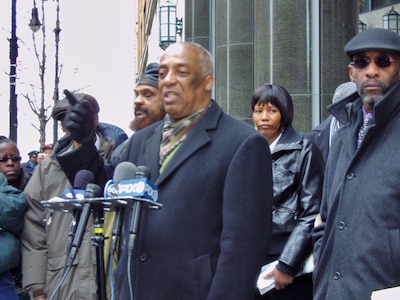
Parents and politicians gathered today outside of prestigious Stuyvesant High School to condemn what they describe as a pattern of racial exclusion and insensitivity at the school.
The group was responding to an amateur rap video that shows four young white men — reportedly Stuyvesant students — using racial slurs. The video emerged after a former student at the school posted it to YouTube.
Recently critics have said that the city’s selective public schools don’t admit enough black and Hispanic students, and that the Department of Education hasn’t fully implemented its own anti-bullying program.
At today’s event outside of the ten-story school building in Lower Manhattan, several parents of students of color talked about their children’s experiences. Veronica Celestin, whose daughter Breanna found the video posted to Facebook, said they were disturbed by the “racist video.”
“This has been a very difficult and traumatic time for Breanna and our family,” said Celestin, reading softly from a typed statement.
Another Stuyvesant parent, Ruth Sowell, said that her child sometimes felt unwelcome at the school. Her son, Michael Bucaoto, is a Stuyvesant football player who is bi-racial.
“They didn’t treat him as an equal,” Sowell said. “He felt he had nowhere to go.”
The percentage of black and Hispanic students admitted to the city’s selective-enrollment schools has declined over the last decade. This year the city offered just 12 black students and 13 Hispanic students spots in the 2011 freshman class at Stuyvesant. Meanwhile, Asian students received 569 offers and white students received 179. In the 2008-2009 school year, just two percent of Stuyvesant’s 3,245 students were black and three percent were Hispanic.
Marge Feinberg, a spokeswoman for the DOE, said the department is improving its outreach to parents in communities where student enrollment in specialized schools is low. She also said that the department is looking into the rap video.
“We are investigating this incident and will take disciplinary action against those involved,” Feinberg said. No Stuyvesant administrators would comment on the video or confirm if any students have already been disciplined, but several students said the four boys in the video have been suspended.
City Councilman Charles Barron criticized Chancellor Cathleen Black today for failing to condemn the video. He also said the DOE should act immediately to send a message to students that harassment is unacceptable.
“This is not a case of ‘boys will be boys,’” Barron said. “This is a form of cyber harassment, cyber terrorism, cyber bullying.”
In 2007, the city launched an anti-bullying program for schools called Respect For All. Last month, City Council Speaker Christine Quinn announced an expansion of the program, which involves staff training and protocols for tracking and dealing with bullying and harassment.
But in a survey of 198 teachers released last month, only 28 said they believed the city’s anti-bullying efforts have been effective. The survey was part of a report published by the Sikh Coalition, the Asian American Legal Defense and Education Fund and the New York Civil Liberties Union (NYCLU).
The report said that despite the city’s detailed anti-bullying plan, many students still don’t know how to report bias-based mistreatment and many schools still fail to investigate reports of harassment.
Feinberg disputed the results of the survey, saying it relies on a “tiny fraction of staff and grossly misrepresents the strides made by our schools.” She also said that every school has a designated staff member to whom students can report bias-related incidents and that 4,000 school employees have participated in a two-day Respect For All workshop.
Donna Lieberman, executive director of the NYCLU, said that the DOE should use the controversy over the video as a “teachable moment” about respect and ways to deal with harassment. But she added that racial imbalance in student enrollment can cause issues at schools.
“I think it’s generally agreed that Stuyvesant High School has a problem. There are very, very few African American students there,” Lieberman said. “And that number has dwindled over the last number of years from merely unacceptable to horrifically unacceptable.”
A Stuyvesant employee who asked not to be named said that the school could do more to promote diversity and discourage harassment.
“People here live in a state of denial,” said the employee, who was not a part of the press event. “Nothing’s done in a proactive way.”
Several students said that racial conflicts are uncommon at the school and the administration takes reports of bullying seriously. They also said that, after the video became public, the administration sent home a letter to families explaining the school’s policy on harassment.
“I don’t like how Stuyvesant is getting a bad name because of it,” said Mohammed Rahman, a sophomore at the school. “It was just kids fooling off.”
Rahman added that the students in the video deserved to be suspended. “They went overboard,” he said. “They really need to understand that racism isn’t accepted at school or in general life.”
